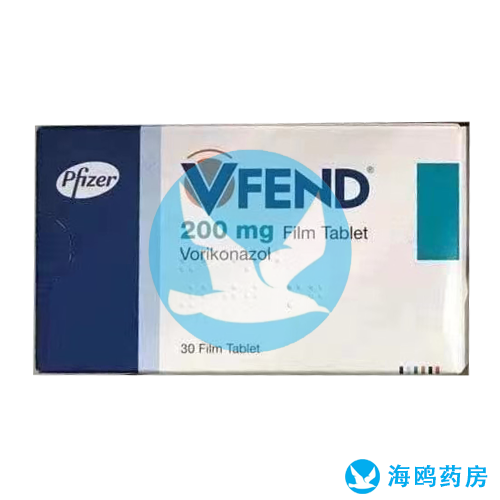
Vfend
Pfizer,USA
$302.00-
SelectSpecification/Number
-
ParameterDetailed information
-
NoticeCustoms clearance instructions
-
Required readingConsumption notice
- Description
- Information
INDICATIONS AND USAGE(适应症)
Invasive Aspergillosis
VFEND is indicated in adults and pediatric patients (2 years of age and older) for the treatment of invasive aspergillosis (IA). In clinical trials, the majority of isolates recovered were Aspergillus fumigatus. There was a small number of cases of culture-proven disease due to species of Aspergillus other than A. fumigatus.
Candidemia in Non-neutropenic Patients and Other Deep Tissue Candida Infections
VFEND is indicated in adults and pediatric patients (2 years of age and older) for the treatment of candidemia in non-neutropenic patients and the following Candida infections: disseminated infections in skin and infections in abdomen, kidney, bladder wall, and wounds.
Esophageal Candidiasis
VFEND is indicated in adults and pediatric patients (2 years of age and older) for the treatment of esophageal candidiasis (EC) in adults and pediatric patients 2 years of age and older.
Scedosporiosis and Fusariosis
VFEND is indicated for the treatment of serious fungal infections caused by Scedosporium apiospermum (asexual form of Pseudallescheria boydii) and Fusarium spp. including Fusarium solani, in adults and pediatric patients (2 years of age and older) intolerant of, or refractory to, other therapy.
DOSAGE(服用剂量)
Important Administration Instructions for Use in All Patients
Administer VFEND Tablets or Oral Suspension at least one hour before or after a meal.
VFEND I.V. for Injection requires reconstitution to 10 mg/mL and subsequent dilution to 5 mg/mL or less prior to administration as an infusion, at a maximum rate of 3 mg/kg per hour over 1 to 3 hours.
Administer diluted VFEND I.V. by intravenous infusion over 1 to 3 hours only. Do not administer as an IV bolus injection.
Use of VFEND I.V. With Other Parenteral Drug Products
Blood products and concentrated electrolytes
VFEND I.V. must not be infused concomitantly with any blood product or short-term infusion of concentrated electrolytes, even if the two infusions are running in separate intravenous lines (or cannulas). Electrolyte disturbances such as hypokalemia, hypomagnesemia and hypocalcemia should be corrected prior to initiation of and during VFEND therapy.
Intravenous solutions containing (non-concentrated) electrolytes
VFEND I.V. can be infused at the same time as other intravenous solutions containing (non-concentrated) electrolytes, but must be infused through a separate line.
Total parenteral nutrition (TPN)
VFEND I.V. can be infused at the same time as total parenteral nutrition, but must be infused in a separate line. If infused through a multiple-lumen catheter, TPN needs to be administered using a different port from the one used for VFEND I.V.
Recommended Dosing Regimen in Adults
Invasive aspergillosis and serious fungal infections due to Fusarium spp. and Scedosporium apiospermum
See Table 1. Therapy must be initiated with the specified loading dose regimen of intravenous VFEND on Day 1 followed by the recommended maintenance dose (RMD) regimen. Intravenous treatment should be continued for at least 7 days. Once the patient has clinically improved and can tolerate medication given by mouth, the oral tablet form or oral suspension form of VFEND may be utilized. The recommended oral maintenance dose of 200 mg achieves a voriconazole exposure similar to 3 mg/kg intravenously; a 300 mg oral dose achieves an exposure similar to 4 mg/kg intravenously. Switching between the intravenous and oral formulations is appropriate because of the high bioavailability of the oral formulation in adults.
Candidemia in non-neutropenic patients and other deep tissue Candida infections
Patients should be treated for at least 14 days following resolution of symptoms or following last positive culture, whichever is longer.
Esophageal Candidiasis
Patients should be treated for a minimum of 14 days and for at least 7 days following resolution of symptoms.
ADVERSE REACTIONS(不良反应)
Hepatic Toxicity
Arrhythmias and QT Prolongation
Infusion Related Reactions
Visual Disturbances
Severe Cutaneous Adverse Reactions
Photosensitivity
Renal Toxicity
For full information, please refer to:
https://nctr-crs.fda.gov/fdalabel/services/spl/set-ids/ce3ef5cf-3087-4d92-9d94-9eb8287228db/spl-doc?hl=Vfend
Vfendinformation
No information yet!!!